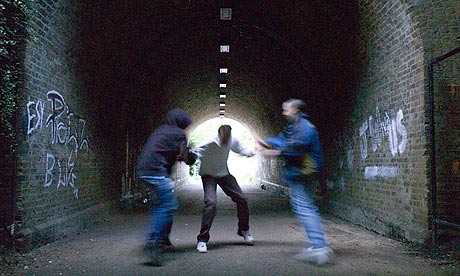
Knife crime among teenagers is a depressingly prevalent headline subject. Sometimes it's possible to believe Britain to be inhabited solely by precocious psychopaths who'll shank you for looking at them funny. But there are antidotes to the anonymous hoodie, pustular and bristling with blades, of the hive imagination. And they can be found in the best contemporary books on knife-crime for teens, which reveal the individuals under the street cowls. Examining the circumstances which conspire to bring victim, aggressor and blade into tragic collision, they help tell the stories behind the strident headlines. After Carol Ann Duffy's poem, Education for Leisure, was pulled from exam syllabuses and volumes containing it pulped, because of an absurd misreading by an examiner who believed that it glorified knife crime, I'm pleased that many YA books are squaring up to the subject and resisting any effort to make it unspeakable.
Anthony McGowan's The Knife That Killed Me is a contender, although it's let down by a heavy-handed schematic device – the repeated reappearance of the eponymous knife, referred to throughout the book in little asides that only serve to put the brakes on the story and underline the author's anxiety to hammer home his message, rather than the message itself. It's a pity, because the story's a corker. Weak-willed, uncertain Paul, seeking a niche in his school's complex and abusive hierarchy, is bullied by the all-but-psychopathic Roth into carrying a heavy, hand-fillingly satisfying sheath knife "for protection". He rejects the alternate life offered him by Shane, the leader of the "freaks", to whom the violent status-jostling of the gangers is water off a duck's back. He also rejects the possibilities opened up to him by Maddy, a well-drawn romantic interest within the same group. Instead, he chooses to carry the knife that comes to define him, that will ultimately cut cleanly across his future.
A more ambitious take on blade-carrying as a means of redefining identity is Keren David's magnificent first novel, When I Was Joe, and its sequel, Almost True – books that conduct a measured, intricate dissection of their protagonist's character, and the white lies and half-truths he tells himself as he attempts to find a version of himself that he can live with. Tyler is highly intelligent and a gifted athlete, but he's unreliable, has a hair-trigger temper, and no ability at all to make a considered response to a difficult situation. His constant, characteristic tension between fury and flight lands him first in witness protection as a key part of the prosecution in a fatal stabbing case (though there are serious discrepancies within the story Tyler tells), then into a relationship with Claire, a shy, withdrawn girl addicted to self-harm. David depicts Tyler and the revelations that slowly, painfully emerge throughout both books with extraordinary shades-of-grey subtlety – and a wry humour to leaven the depressing subject matter. The book is rightly longlisted for the 2011 Carnegie Medal.
Patrick Ness's The Knife of Never Letting Go may not leap to mind alongside teenage knife crime, despite the title; the setting isn't an inner-city estate but a distant planet in a dystopian future. But, like Paul and Tyler, Ness's leading man, Todd, is under enormous pressure to define himself by means of a blade: as a man, which in his fragmented and savage society must involve a killing; or as himself, an almost-man who doesn't – can't – kill. The knife, like McGowan's, is lovingly described: "the big ratchety one with the bone handle and the serrated edge that cuts practically everything in the world, the knife I was hoping to get for the birthday when I become a man." Like its inheritor, the knife occupies an ambiguous position; out of context, it's a meaningless lump of metal; in the well-ordered context of Todd's everyday life it's useful, well-made, and beneficial; but in the context of a world turned cancerously in on itself, it's lethal.
Although these books don't flinch from condemning the bad decisions and cowardice that make murderers of teenagers who choose to carry blades, they also help elucidate how it's possible for a boy to become a killer before he's a man.

